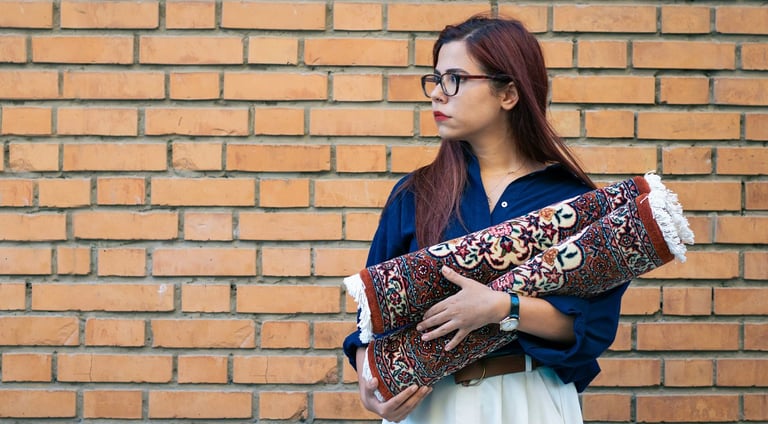New Book to celebrate International Day of Peace
When Light Fades Joy
Can light affect prized collections? Through Avani’s story about her collection of silken carpets we understand the concept of deterioration and the reality of the effect of light on our collections. We also learn how Avani can use simple preventive strategies to protect and preserve her legacy. Hope you enjoy the read.
Kiran Java
8/23/20256 min read


We welcome light into our homes and our lives. It could be the soft stream of sunlight through an open window, or the early morning rays of the sun on our patio, we consider light as beneficial to our physical being. Light is known to brighten our day, enhance our productivity or even create an ambience of aesthetic beauty.
But what about the role that light has on our collections? Those objects that hold a historical or emotional significance in our lives? These could be a shawl belonging to our grandmother, a decorative jewellery box belonging to our grand aunt, the canvas our mother had painted, or a chola bronze that we had carefully acquired. We place or display our prized collections at our home, to be viewed and admired by us and our loved ones. We feel the emotion of pure joy when we are surrounded by our collections. But how often do we pause to consider the quiet toll that light, natural or artificial, might be taking on them?
Avani had collected five palm sized pieces of silken carpet that were of various hues of navy and deep red. She had placed two of them on a wall opposite the window where she liked to drink her morning coffee in the early morning hours. The sun filtered through the windows and created beautiful patterns near her display of silken carpets. In the evenings, when the sun had set, Avani would switch on a bright LED light that she had installed over the wall display to view her collection.
The other three carpets in her collection were placed in a drawer in her lobby. After some time passed she took them out from the drawer and held it against the two displayed on the wall and to her surprise the ones on the wall looked slightly faded. On closer inspection she also noticed a hole near the fringe area of the carpet. Avani was dismayed to see her prized collection damaged.
Avani had displayed half her collection and had stored away the other half. With the help of the stored collection by comparing both, she was able to notice visible damage to her displayed collection. But what exactly happened to Avani’s display and could she have averted the damage?
The light in the morning was soft and light so Avani never thought that it would damage her collection. But in reality the sunlight over time, relentlessly falling on her collection, managed to fade the silken carpets. Then again in the evening, the LED that fell on the collection was too bright. In both cases, it was the time and intensity of the light that was the culprit.
There is a field of study that believes in taking certain actions that prevent or lessen damage to our prized collections. This field of study is known as Preventive Conservation. In Preventive Conservation light is a well known ‘agent of deterioration’. Deterioration is defined as the irreversible process of material decline, where an object's physical or chemical properties are altered due to various factors, leading to its weakened, worn, or damaged state.
There are well known agents or causes of deterioration which include physical forces such as the article dropping or pressure applied to it that causes tears or dents, pests such as rodents or silverfish and other insects, environmental pollution, temperature and humidity fluctuations, inherent instability which is the natural instability built into certain objects inherently where they naturally degrade over time and exposure to light. Other agents are the more obvious ones such as theft and vandalism, water leaks or flooding and fire. A lesser known agent of deterioration is dissociation which is the loss of objects, or object-related data, or the ability to retrieve or associate objects and data that often happen in catastrophic events.
How did light affect Avani’s collection?
Prolonged exposure to light causes fading or in the case of organic objects it results in chemical breakdown. Let’s see the ways in which light both impacted and perhaps also did not impact Avani’s collection.
The exposure to sunlight destroyed the molecular structure and caused the deep red and navy to fade over time.
Unknown to Avani, another process was taking place silently and that was the light breaking down the long polymer chains that provided the strength to the carpets. As a result the collections were slowly becoming brittle and could tear over time.
Luckily the colours were deep in hue otherwise the light could also create oxidation of the components and they could have turned yellow over time.
If there was any leakage on the wall that they were displayed then it could have resulted in weathering, cracking or even mold and fungus.
What can Avani do to prevent damage to her display? What if Avani was using the carpet on the floor? How would she preserve her legacy?
The field of study of Preventive Conservation lists certain measures that can be taken by collectors to take better care of their collections. Let us see what simple measures Avani can take to protect and preserve her collections.
First of all Avani has to draw curtains on her window to avoid direct sunlight hitting the display. She should never expose the silk fibers to direct sunlight.
The next thing she has to do is procure the correct overhead LED light. The industry practice is to measure the intensity of Light in ‘Lux’ and a certain level of Lux is prescribed for certain collections. For example, in retail displays it is in the norm to use 500 to 1000 Lux so that clothing looks appealing and the customers can easily judge the patterns and colour choice. For purposes of sewing and weaving textiles, the lux in above 750. However in the case of displaying textiles such as silk carpet the Lux has to be a maximum of 50 Lux.
Other things Avani can do is place them in a climate controlled environment that is cool. She should ensure humidity is between 40% to 60% to avoid mold and/or brittleness of the fibre.
She should use the right cleaning approach such as a low level suction on her vacuum and move the vacuum in the direction of the pile to avoid damage to the fibers.
She should not place mothballs near the collection as they have chemicals that damage the silken fibers.
The rest of Avani’s collection that is stored should be placed in muslim cloth as a protective wrap and she should not use plastic to store them.
What if Avani was using the carpet on the floor? How would she preserve her legacy?
Luckily Avani is displaying her silken carpets on a wall and not using the carpet on the floor. However, if Avani was using the carpets then there would be other things to take into consideration. First she would have to place a padding before placing it on the floor as a protection to the underside of the carpet. Rotation of the rug to minimize wear and tear. Avani should place pads under furniture legs if she is placing heavy furniture on the carpet, and additionally she should change the position of the furniture slightly to avoid constant pressure on the carpet.
The above offers a brief overview of the preventive conservation strategies Avani can use to care for her collection.
In the words of Dr. Achal Pandya, Head of Conservation & Cultural Archives at Indira Gandhi National Centre for the Arts, “Preventive conservation can be done by anyone interested as it does not require the object to be touched. One works around the object, improves its surroundings and protects art works from dust, light and common aggressors”. Let us remember that while preventive conservation is a relatively young field, having formally emerged in 1952 in Belgium, it is more relevant than ever today, especially in countries with vast collections, both public and private.
And as we saw with Avani’s collection, it’s often the smallest signs, like that little hole in the fringe, that remind us why this care matters. We’ll explore the cause of that in the next article Link: https://www.kiranjava.com/cedar-to-the-rescue. Until then, take care and remember, prevention is the art of preserving lasting legacies.
About the Author:
Kiran Java has participated in the Preventive Conservation of Paintings workshop by the Indian National Trust for Art and Heritage (INTACH) in 2025 and is studying Preventive Conservation at the Bhandarkar Oriental Research Institute. She is a member of the Indian Association for the Study of Conservation of Cultural Property (IASC) and is passionate about raising awareness on preventive conservation. With a Masters degree in Mass Communication and Journalism, Kiran is skilled at sharing complex preservation conservation concepts in an accessible way. She is currently on a mission to write a series of articles to help collectors protect and preserve their cherished collections.
Thank you for your feedback!

